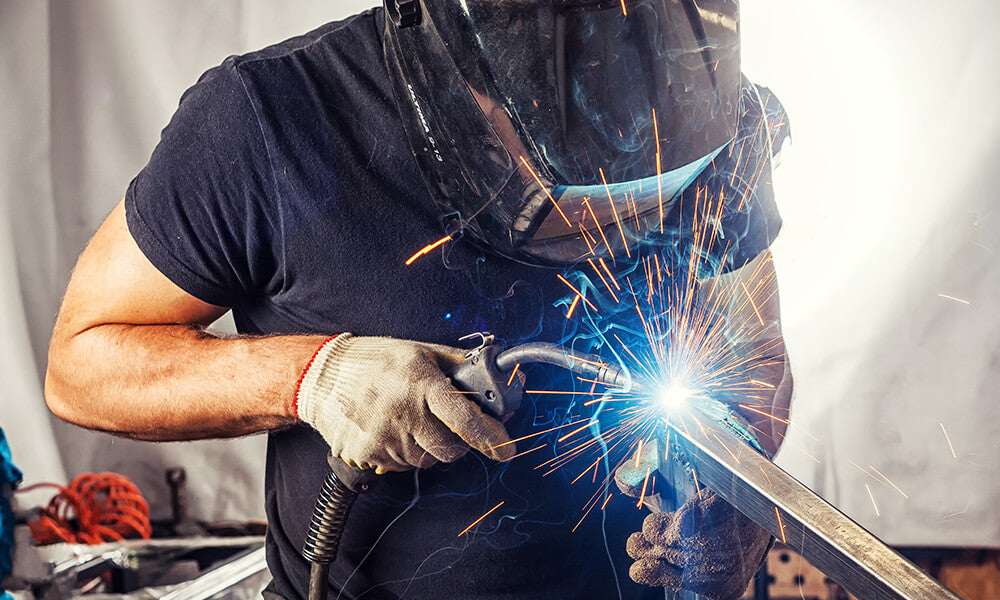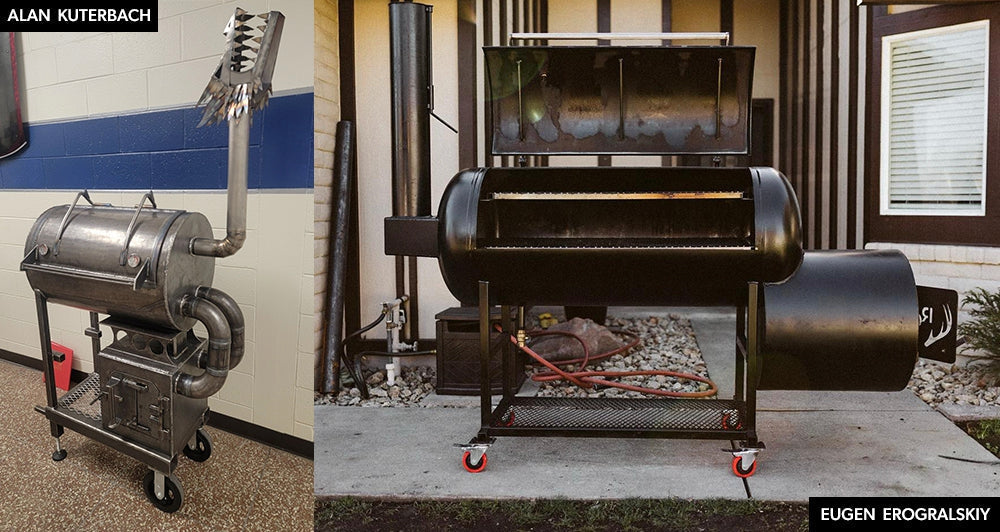Are you sick of being tethered to walls? It’s a frustrating experience to be limited based on the location of the nearest electric socket. Ultimate freedom comes from being able to weld anything, anywhere. And that’s why a generator is a welder’s best friend.
But anyone who has shopped for a generator before knows that it can feel overwhelming. Most generators don’t simply list if they can run a welding machine or not. Instead, they list a series of numbers that can make you feel like you're trying to crack the zodiac code. But don’t worry, once you know what you’re looking at, finding the right generator is easy. Plus, by running the actual numbers, you can relax knowing you’re buying a generator that’ll meet your needs, no guessing game required.

Step 1: Calculating your Welder’s Power Needs
Before looking at generators, you’ll need to figure out how much power you need to run your equipment. To do this, you’ll need to figure out how many watts each machine requires. The problem is that most welding machines won’t simply list how many watts they need. This is because welding machines’ power requirements can change depending on if you’re using a 120 or 240 volt plug, on what process you're using (with multi process machines), etc.
Luckily calculating watts is easy if you know how to do it. Watt’s formula is just your Amps x Voltage. You can find both these numbers in the user manual of your machine, online and often even printed on the side of your equipment.
To give you an example, here we’re looking at the details in the Millermatic 211’s spec sheet. First, we find its max input amps for both 120 and 240 volts. As you can see, Miller states it takes 24.3 amps at 120 volts and 16.6 amps at 240 volts.

So, using the formula: Amps x Volts = Watts, we can calculate that the Millermatic 211 running on a 120 volt plug will use 2,916 watts (120 x 24.3). With a 240 volt plug, it’ll use 3,984 watts (240 x 16.6).
Those numbers are how much power we need to continuously run the Millermatic 211 on 120 and 240 volts. Now obviously you wouldn’t be running the 120 volt plug and 240 volt plug at the same time, so you just need to make sure the generator can handle the largest number (which is generally the 240 volt calculation). Again, this is the minimum amount of “continuous watts” your generator will need to run a Millermatic 211. We’ll show you below how to figure out how many “peak watts” your generator needs.
Peak Watt Calculations
Almost all electrical equipment uses an extra boost of power to get started when you first turn it on. Usually, it’s only for a brief moment, but it is something you have to take into account. Most generators are designed to handle a little extra umph for a few seconds when you first start up your equipment. Your generator will call this “peak watts.”

Some welding machines will list their “start-up watts” on their spec sheet. However, if they don’t, a lot of experts will simply take the machine’s running watts and add another 30%. So for instance, in the Millermatic 211 above:
To find the 120 volt start-up watts, we take the 2,916 watts we found above and add an additional 30% more. So the calculations look like this:
2916 x 1.30 = 3,790 watts.
We do the same thing for the 240 volt:
3,984 x 1.30 = 5,179.2 watts
Again, if you want to be able to run your welder on both 120 volt and 240 volt settings, you aren’t going to be doing both at the same time. So you only need to look at the largest number of the two when finding a generator that can handle your needs.
Now we know that if we want to run our Millermatic 211 at 240 volts off a generator, it’ll require 3,984 continuous watts and 5,179.2 peak watts. The next step is finding a generator that meets those requirements.
Step 2: Finding the Right Generator
There are several things we’ll cover when looking for a generator that meets your needs, but the first thing you’ll want to check is that it exceeds your power requirements. If you purchase a generator that is below your needs, it’ll either damage your equipment, fry the generator, or simply shut the generator off (if it has overload protection).
What you’re looking for is the generator's “continuous watt output” and “peak watt output.” So for example, the Miller Bobcat 225 lists its peak watts at 11,000 and its continuous watts at 9,500 (see spec sheet below).

The Bobcat already has a built-in welder , but let’s say we also wanted to run a second welding machine from its generator. Could we run the Millermatic 211 based on the numbers we calculated above?
We found that the Millermatic 211 at 240 volts required 3,984 running (or continuous) watts. The Bobcat 225 lists its continuous output at 9,500 watts. But as we mentioned, you also need to check the peak watts. We calculated that the Millermatic 211 at 240 volts requires 5,179.2 watts when it first starts up. The Bobcat 225 says it’s rated for up to 11,000 watts of peak output. Both our power requirement numbers are well below the generator’s specs, so we can absolutely run a Millermatic 211 off a Bobcat 225.
This means we could even run additional equipment at the same time as a Millermatic 211 off a Bobcat 225. Or, If you only ever plan on running a Millermatic 211, the Bobcat 225 might be overkill and you could save yourself some money by getting a generator that’s closer to your needs.
Dirty Power
Another small thing to keep in mind when finding a generator to meet your needs is what is often called “dirty power.” The more accurate name is THD. Basically a generator produces small power fluctuations called “harmonic distortion.” Inverter welders use sensitive electronics to help reduce their size and create a smoother arc, but they can become damaged by too many of these harmonic distortions.
If you’re planning on running an inverter welder off your generator, you need to make sure it has a THD of below 6%. If you’re using a transformer welder, you don’t need to worry nearly as much about THD.
Other Equipment
Let’s say you wanted to run other equipment either beside or alongside your welder. What type of power requirements would those take? Most tools will either list the required watts or how many amps they use (which you can then calculate watts like how we did above). However, we’ve put together a basic list here. Note that this is just a general list and you should absolutely check your tool’s manual for exact power requirements.
| Equipment | Continuous Watts | Starting Watts |
| Radio | 50-200 | 0 |
| 7-1/4in. Circular Saw | 1400 | 2300 |
| 8in. Bench Grinder | 1400 | 2500 |
| Drill: 1/2in., 5.4 Amps | 600 | 900 |
| Pressure Washer: 1 HP | 1200 | 3600 |
| Electric Chain Saw: 14in. Bar, 2 HP | 1100 | 0 |
| Single 60W equivalent CFL bulb | 15 | 0 |
Final Things to Remember
The numbers listed for both your equipment and your generator can sometimes be exaggerated or tested in perfect conditions. While the more trusted brands have more accurate numbers, it’s still generally best to give yourself some tolerances.
Many welders will use 126 volts and 253 volts instead of 120 and 240 when doing their calculations. Others will tack on an additional 5% to their total power requirements. However you choose to do it, just know that you’ll want some breathing room between your required power and what your generator can do.
Another thing to note is that higher altitudes can affect your generator’s performance. Manufacturers generally advise planning on a 3.5% power loss for every 1,000 feet of elevation. Sometimes you can find “high altitude kits” for your generator that can help with this.
With this information, you now have the confidence to find a generator perfect for your needs. We’ve recently introduced some new high-quality generators from Generac into our collection. The best part is that they’re in-stock and ready to ship. Check them out for yourself below:





